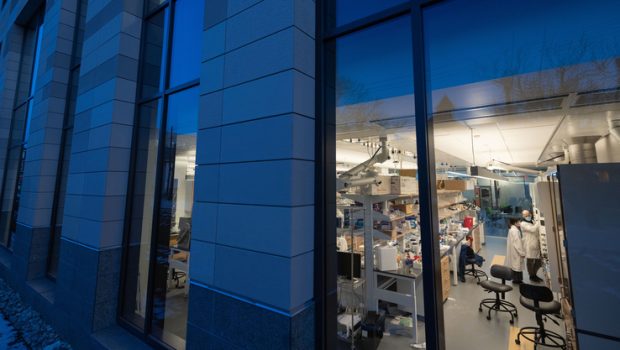New Health, Science and Technology Building: A Hub for Interdisciplinary Research
Views inside the new Health, Science and Technology Building where glass walls and open spaces, along with meeting areas set up around the perimeter, encourage people to collaborate. An outdoor pedestrian walkway connects the building to Seeley-Mudd, Sinclair and Whitaker labs.
The welcoming spaces are set up around the perimeter of the building with faculty offices in the center, a strategic design that ensures professors will be among their students as soon as they step outside their offices.
“There will be lots of interactions, lots of engagement between faculty members, students and research staff,” Urban said. “The structure of the building is designed to foster these interactions with labs that are very open. Even walking upstairs can be a barrier in some buildings, but the way HST was designed was to invite people to see what’s happening on each floor, to easily move between spaces.”
At nightfall, “Lehigh” is illuminated in LED lights at the top of the building, a 60-foot-by-10-foot beacon visible from various vantage points across the city. The café on the first level has a “green roof” overtop where native plants sprout, and the upper windows with western and southern exposure have solar shades that mimic the microscopic image of a cell.
It’s all very modern with lots of metal and glass, but the entranceway doors, Project Manager Joe Klocek ’98, pointed out, are wood. That design decision was a nod to Lehigh’s oldest buildings, which also feature heavy wood doors.
Designing Lehigh’s Newest Research Facility
HST was designed by HGA, a national interdisciplinary design firm.
Throughout the academic world, there’s a growing idea that buildings should no longer be department-specific, but interdisciplinary, said Bill Wilson, an architect and principal with HGA’s science and technology division in Boston.
“In the design profession, the spaces we are trying to guide clients to use are generic spaces that can be reassigned to anticipate unknown change. You can call that flexibility, but also sustainability or resilience,” Wilson said.
“We are looking at three to four generations of faculty who will be doing things here that were undreamed of at the outset of the building. It needs to be very robust so that it can adapt itself to a lot of different arrangements and equipment.”








Gloss